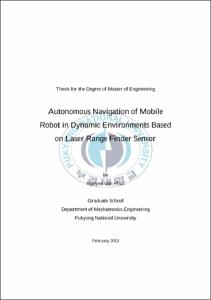AUTONOMOUS NAVIGATION OF MOBILE ROBOT IN DYNAMIC ENVIRONMENTS BASED ON LASER RANGE FINDER SENSOR
- Abstract
- Autonomous navigation of a mobile robot in dynamic environments is a fundamental requirement for effective autonomous navigation and widely used in large fields of industrial application. The past few years have been tremendous growth in the research areas of autonomous navigation of a mobile robotics. Navigation encompasses the ability of the robot to act based on its knowledge and sensor values so that it could reach its goal position as efficiently and reliably as possible. Navigation involves mapping, localization and predict motion planning while colliding avoidance for mobile robots. The mapping is the process whereby a robot can extract relevant information from its environment allowing it to remember it. Localization is the problem of estimating a robot’s pose relative to a map of its environment. Localization and mapping is based on data collected from a robot using a dense range scanner to generate a bi dimensional map representation of the surrounding environment. This externally sensed range data is correlated to estimate the robot’s position and build a map. Path planning for a mobile robot is to find a collision free route, through the robot’s environment with obstacles, from a specified start location to a desired goal destination while satisfying certain optimization criteria.
This thesis focuses on the problem of enabling mobile robots to build world models of their environment and to employ as a reference to self-localization and path planning. The robot usually needs a representation of the environment and the capacity to interpret that representation to be able to plan a path towards some target location and to move safely in an environment where there may be variations in the position of the robots. The system builds bi dimensional maps of the environment that surrounds the robot, through data collected from the laser range finder sensor and also the estimated position of the robot. This research is geared towards implementing Local Registration/ Global Correlation (LRGC) algorithm for reliable reconstruction of consistent global maps from scanning laser data. The localization is carried out through stored environment maps by using scan matching method. The path planning task uses a focused D* (FD) search to compute the shortest and safest path from the present robot position to any reachable point in the given robot environment map. Once the main path is planned, a local segment of the path to plan around any unmapped obstacles it sees with its range sensors is recomputed. The dynamic window method is used to compute the translational and rotational velocities necessary to follow the path as closely as possible.
Experiments using data collected from a SICK LMS-200 laser range finder illustrate the effectiveness of the algorithms and improvements over previous work. All the algorithms are implemented and verified using a Pioneer 3DX mobile robot equipped with the laser range finder. Experimental results for both the simulation and real world environment show that the method improves the accuracy of localization and mapping.
- Issued Date
- 2013
- Awarded Date
- 2013. 2
- Type
- Dissertation
- Publisher
- 부경대학교
- Affiliation
- 부경대학교 대학원
- Department
- 대학원 메카트로닉스공학과
- Advisor
- 안두성
- Table Of Contents
- ACKNOWLEDGEMENTS
ABSTRACT i
CONTENTS v
LIST OF FIGURES vii
LIST OF TABLES ix
NOMENCLATURE x
1. INTRODUCTION 1
2. MAP BUILDING 6
2.1. Scan matching 9
2.1.1. Scan 10
2.1.2. Feature extraction from scanning data 11
2.1.3. Median Filter 17
2.1.4. Scan matching 18
2.2. Consistent position estimate 33
2.2.1. Definition of the estimation problem 34
2.2.2. Application for the mapping 37
2.3 Map Correlation 38
2.4 LRGC algorithm 40
3. LOCALIZATION 42
3.1 Dead Reckoning 43
3.2 Categories of localization methods 46
3.3 Scan matching localization 47
4 PATH PLANNING AND COLLISION AVOIDANCE 49
4.1 Path planning 49
4.1.1 Approaches for path planning 51
4.1.2 FD * path planning algorithm 54
4.2 Collision Avoidance Behavior 64
4.2.1 Modeling of Wheeled Mobile Robot (WMR) 65
4.2.2 General Motion equations 66
4.2.3 Dynamic Window Approaches 68
5 EXPERIMENTAL RESULTS 71
5.1 Simulation results 71
5.2 Experimental results 73
6 CONCLUSIONS 81
6.1 Summary 81
6.2 Research limitations 82
6.3 Direction for future research 83
APPENDIX 85
REFERENCES 92
- Degree
- Master
- Files in This Item:
-
-
Download
 AUTONOMOUS NAVIGATION OF MOBILE ROBOT IN DYNAMIC ENVIRONMENTS BASED ON LASER RANGE FINDER SENSOR.pdf
기타 데이터 / 3.85 MB / Adobe PDF
AUTONOMOUS NAVIGATION OF MOBILE ROBOT IN DYNAMIC ENVIRONMENTS BASED ON LASER RANGE FINDER SENSOR.pdf
기타 데이터 / 3.85 MB / Adobe PDF
-
Items in Repository are protected by copyright, with all rights reserved, unless otherwise indicated.